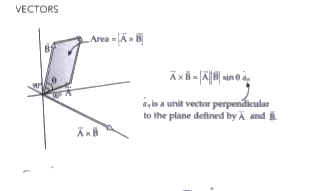Show that |→a|→b−∣∣→b∣∣→a, for any two non - zero vectors →a and →b.
To show that |→a|→b−|→b|→a=→0 for any two non-zero vectors →a and →b, we can follow these steps:
Step 1: Understanding the Magnitudes
Let |→a| denote the magnitude (length) of vector →a and |→b| denote the magnitude of vector →b.
Step 2: Express the Vectors
We can express the vectors in terms of their magnitudes and directions. Let:
→a=|→a|^a
→b=|→b|^b
where ^a and ^b are the unit vectors in the direction of →a and →b respectively.
Step 3: Substitute into the Expression
Substituting the expressions for →a and →b into the expression |→a|→b−|→b|→a:
|→a|→b=|→a|(|→b|^b)=|→a||→b|^b
|→b|→a=|→b|(|→a|^a)=|→b||→a|^a
Thus, we have:
|→a|→b−|→b|→a=|→a||→b|^b−|→b||→a|^a
Step 4: Factor Out Common Terms
Since both terms have the common factor |→a||→b|, we can factor it out:
|→a||→b|(^b−^a)
Step 5: Conclusion
The expression |→a||→b|(^b−^a) is equal to zero if ^b=^a or if the magnitudes are zero. However, since →a and →b are non-zero vectors, the only way for this expression to equal zero is if ^a and ^b are in the same direction, which means:
|→a|→b−|→b|→a=→0
Thus, we have shown that:
|→a|→b−|→b|→a=→0
Let |→a| denote the magnitude (length) of vector →a and |→b| denote the magnitude of vector →b.
We can express the vectors in terms of their magnitudes and directions. Let:
→a=|→a|^a
→b=|→b|^b
where ^a and ^b are the unit vectors in the direction of →a and →b respectively.
Substituting the expressions for →a and →b into the expression |→a|→b−|→b|→a:
|→a|→b=|→a|(|→b|^b)=|→a||→b|^b
|→b|→a=|→b|(|→a|^a)=|→b||→a|^a
Thus, we have:
|→a|→b−|→b|→a=|→a||→b|^b−|→b||→a|^a
Since both terms have the common factor |→a||→b|, we can factor it out:
|→a||→b|(^b−^a)
The expression |→a||→b|(^b−^a) is equal to zero if ^b=^a or if the magnitudes are zero. However, since →a and →b are non-zero vectors, the only way for this expression to equal zero is if ^a and ^b are in the same direction, which means:
|→a|→b−|→b|→a=→0
|→a|→b−|→b|→a=→0
Topper's Solved these Questions
- VECTOR ALGEBRA BOOK - MODERN PUBLICATIONCHAPTER - VECTOR ALGEBRA EXERCISE - EXERCISE 10 (e ) Long Answer Type Questions (I)
25 Videos
- VECTOR ALGEBRA BOOK - MODERN PUBLICATIONCHAPTER - VECTOR ALGEBRA EXERCISE - EXERCISE 10 (e ) Long Answer Type Questions (II)
4 Videos
- VECTOR ALGEBRA BOOK - MODERN PUBLICATIONCHAPTER - VECTOR ALGEBRA EXERCISE - EXERCISE 10 (d) Long Answer Type Questions (II)
1 Videos
- THREE DIMENSIONAL GEOMETRY BOOK - MODERN PUBLICATIONCHAPTER - THREE DIMENSIONAL GEOMETRY EXERCISE - CHAPTER TEST 11
11 Videos
Similar Questions
Knowledge Check
If →a,→b,→c be three non - zero vectors satisfying the condition →a×→b=→cand→b×→c=→a , then .
A→a,→b,→c are orthogonal is pairsB[→a,→b,→c]=[→a]2C[→a→b→c]=[→c]D∣∣→b∣∣=|→c|If →A,→B&→A+→B are three non− zero vector. Such that →A+→B is perpendicular to →B then which of one is correct :
AA≥BBA≥B√2CA>BDA>B√2For non-zero vectors →aand→bif∣∣→a+→b∣∣<∣∣→a−→b∣∣,then →aand→b are
AcollinearBperpendicular to each otherCinclined at an acute angleDinclined at an obtuse angle
If →a,→b and →c are mutually perpendicular unit vectors and →a×→b=→c, show that →b=→c×→a and →a=→b×→c.
View SolutionIf →A×→B=0, what can be said about the non-zero vectors →A and →B ?
View SolutionShow that the vectors →a,→b,→c are coplanar if and only if →a+→b,→b+→c and →c+→a are coplanar.
View SolutionThe cross product of two vectors gives a vector perpendicular to the plane containing the vectors.

If →a and →b are non-zero vectors, then →a⋅(→a×→b)= _________
View SolutionIf →A and →B are two non-zero vectors such that ∣∣→A+→B∣∣=∣∣→A−→B∣∣2 and ∣∣→A∣∣=2∣∣→B∣∣ then the angle between →A and →B is :
View Solution
